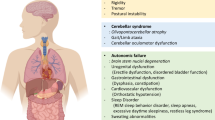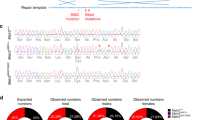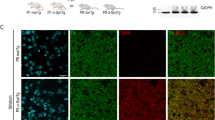Abstract
Recent research has significantly advanced our understanding of the molecular mechanisms of neurodegenerative diseases, including Alzheimer's disease (AD) and motor neuron disease. Here we emphasize the use of genetically engineered mouse models that are instrumental for understanding why AD is a neuronal disease, and for validating attractive therapeutic targets. In motor neuron diseases, Cu/Zn superoxide dismutase and survival motor neuron mouse models are useful in testing disease mechanisms and therapeutic strategies for amyotrophic lateral sclerosis (ALS) and spinal motor atrophy, respectively, but the mechanisms that account for selective motor neuron loss remain uncertain. We anticipate that, in the future, therapies based on understanding disease mechanisms will be identified and tested in mouse model systems.
This is a preview of subscription content, access via your institution
Access options
Subscribe to this journal
Receive 12 print issues and online access
$209.00 per year
only $17.42 per issue
Buy this article
- Purchase on Springer Link
- Instant access to full article PDF
Prices may be subject to local taxes which are calculated during checkout

Bob Crimi

Amy Center
Similar content being viewed by others
References
Price, D.L., Tanzi, R.E., Borchelt, D.R. & Sisodia, S.S. Alzheimer's disease: genetic studies and transgenic models. Annu. Rev. Genet. 32, 461–493 (1998).
Lee, V.M.Y. & Trojanowski, J.Q. Neurodegenerative taupathies: human disease and transgenic mouse models. Neuron 24, 507–510 (1999).
Lin, X., Cummings, C.J. & Zoghbi, H.Y. Expanding our understanding of polyglutamine diseases through mouse models. Neuron 24, 499–502 (1999).
Dunnett, S.B. & Bjorklund, A. Prospects for new restorative and neuroprotective treatments in Parkinson's Disease. Nature 399, A32–A39 (1999).
Yamamoto, A., Lucas, J.J. & Hen, R. Reversal of neuropathology and motor dysfunction in a conditional model of Huntington's disease. Cell 101, 57–66 (2000).
Hardy, J. & Gwinn-Hardy, K. Genetic classification of primary neurodegenerative disease. Science 282, 1075–1079 (1998).
Selkoe, D.J. Alzheimer's disease: genes, proteins and therapy. Physiol. Rev. 81, 741–766 (2001).
Price, D.L., Sisodia, S.S. & Borchelt, D.R. Genetic neurodegenerative diseases: the human illness and transgenic models. Science 282, 1079–1083 (1998).
Schilling, G. et al. Intranuclear inclusions and neuritic pathology in transgenic mice expressing a mutant N-terminal fragment of huntingtin. Hum. Mol. Genet. 8, 397–407 (1999).
Goedert, M., Spillantini, M.G. & Davies, S.W. Filamentous nerve cell inclusions in neurodegenerative diseases. Curr. Opin. Neurobiol. 8, 619–632 (1998).
Zoghbi, H.Y. & Orr, H.T. Polyglutamine diseases: protein cleavage and aggregation. Curr. Opin. Neurobiol. 9, 566–570 (1999).
Albert, M.S. & Drachman, D.A. Alzheimer's disease. What is it, how many people have it, and why do we need to know? Neurology 55, 166–168 (2000).
Mesulam, M.M. Neuroplasticity failure in Alzheimer's disease: bridging the gape between plaques and tangles. Neuron 24, 521–529 (1999).
Price, D.L. & Sisodia, S.S. Mutant genes in familial Alzheimer's disease and transgenic models. Annu. Rev. Neurosci. 21, 479–505 (1998).
Beach, T.G. et al. The cholinergic deficit coincides with Aβ deposition at the earliest histopathologic stages of Alzheimer disease. J. Neuropathol. Exp. Neurol. 59, 308–313 (2000).
Serpell, L.C., Blake, C.C.F. & Fraser, P.E. Molecular structure of a fibrillar Alzheimer's Aβ fragment. Biochemistry 39, 13269–13275 (2000).
Lansbury, P.T. Jr. Evolution of amyloid: what normal protein folding may tell us about fibrillogenesis and disease. Proc. Natl. Acad. Sci. USA 96, 3342–3344 (1999).
Tanzi, R.E. New frontiers in Alzheimer's disease genetics. Neuron 32, 181–184 (2001).
Selkoe, D.J. Clearing the brain's amyloid cobwebs. Neuron 32, 177–180 (2001).
Sinha, S. et al. Purification and cloning of amyloid precursor protein β-secretase from human brain. Nature 402, 537–540 (1999).
Hussain, I. et al. Identification of a novel aspartic protease (Asp 2) as β-secretase. Mol. Cell. Neurosci. 14, 419–427 (1999).
Lin, X. et al. Human aspartic protease memapsin 2 cleaves the β-secretase site of β-amyloid precursor protein. Proc. Natl. Acad. Sci. USA 97, 1456–1460 (2000).
Yan, R. et al. Membrane-anchored aspartyl protease with Alzheimer's disease β-secretase activity. Nature 402, 533–537 (1999).
Vassar, R. et al. β-secretase cleavage of Alzheimer's amyloid precusor protein by the transmembrane aspartic protease BACE. Science 286, 735–741 (1999).
Wong, P.C., Price, D.L. & Cai, H. The brain's susceptibility to amyloid plaques. Science 293, 1434–1435 (2001).
Farzan, M., Schnitzler, C.E., Vasilieva, N., Leung, D. & Choe, H. BACE2, a β-secretase homolog, cleaves at the β site and within the amyloid-β region of the amyloid-β precursor protein. Proc. Natl. Acad. Sci. USA 97, 9712–9717 (2000).
Nilsberth, C. et al. The 'Arctic' APP mutation (E693G) causes Alzheimer's disease by enhanced Aβ protofibril formation. Nat. Neurosci. 4, 887–893 (2001).
Sherrington, R. et al. Cloning of a gene bearing missense mutations in early-onset familial Alzheimer's disease. Nature 375, 754–760 (1995).
Levy-Lahad, E. et al. Candidate gene for the chromosome 1 familial Alzheimer's disease locus. Science 269, 973–977 (1995).
Rogaev, E.I. et al. Familial Alzheimer's disease in kindreds with missense mutations in a gene on chromosome 1 related to the Alzheimer's disease type 3 gene. Nature 376, 775–778 (1995).
Thinakaran, G. et al. Endoproteolysis of presenilin 1 and accumulation of processed derivatives in vivo. Neuron 17, 181–190 (1996).
Sisodia, S.S. & George-Hyslop, P.H. gamma-secretase, Notch, Aβ and Alzheimer's disease: where do the presenilins fit in? Nat. Rev. Neurosci. 3, 281–290 (2002).
Esler, W.P. & Wolfe, M.S. A portrait of Alzheimer secretases—new features and familiar faces. Science 293, 1449–1454 (2001).
Vassar, R. & Citron, M. Aβ-generating enzymes: recent advances in β- and γ-secretase research. Neuron 27, 419–422 (2000).
De Strooper, B. et al. Deficiency of presenilin-1 inhibits the normal cleavage of amyloid precursor protein. Nature 391, 387–390 (1998).
Wolfe, M.S. et al. Two transmembrane aspartates in presenilin-1 required for presenilin endoproteolysis and secretase activity. Nature 398, 513–517 (1999).
Kopan, R. & Goate, A. Aph-2/Nicastrin: an essential component of gamma-secretase and regulator of notch signaling and presenilin localization. Neuron 33, 321–324 (2002).
Calhoun, M.E. et al. Neuronal overexpression of mutant amyloid precursor protein results in prominent deposition of cerebrovascular amyloid. Proc. Natl. Acad. Sci. USA 96, 14088–14093 (1999).
Chen, G. et al. A learning deficit related to age and β-amyloid plaques in a mouse model of Alzheimer's disease. Nature 408, 975–979 (2000).
Mucke, L. et al. High-level neuronal expression of Aβ1-42 in wild-type human amyloid protein precursor transgenic mice: synaptotoxicity without plaque formation. J. Neurosci. 20, 4050–4058 (2000).
Hsia, A.Y. et al. Plaque-independent disruption of neural circuits in Alzheimer's disease mouse models. Proc. Natl. Acad. Sci. USA 96, 3228–3233 (1999).
Lewis, J. et al. Enhanced neurofibrillary degeneration in transgenic mice expressing mutant tau and APP. Science 293, 1487–1491 (2001).
Götz, J., Chen, F., Barmettler, R. & Nitsch, R.M. Tau filament formation in transgenic mice expressing P301L tau. J. Biol. Chem. 276, 529–534 (2001).
Borchelt, D.R. et al. Accelerated amyloid deposition in the brains of transgenic mice co-expressing mutant presenilin 1 and amyloid precursor proteins. Neuron 19, 939–945 (1997).
Zheng, H. et al. β-amyloid precursor protein-deficient mice show reactive gliosis and decreased locomotor activity. Cell 81, 525–531 (1995).
Heber, S. et al. Mice with combined gene knock-outs reveal essential and partially redundant functions of amyloid precursor protein family members. J. Neurosci. 20, 7951–7963 (2000).
Struhl, G. & Greenwald, I. Presenilin is required for activity and nuclear access of notch in drosophila. Nature 398, 522–525 (1999).
Wong, P.C. et al. Presenilin 1 is required for Notch1 and Dll1 expression in the paraxial mesoderm. Nature 387, 288–292 (1997).
Donoviel, D. et al. Mice lacking both presenilin genes exhibit early embryonic patterning defects. Genes Dev. 13, 2801–2810 (1999).
Yu, H. et al. APP processing and synaptic plasticity in presenilin-1 conditional knockout mice. Neuron 31, 713–726 (2001).
Feng, R. et al. Deficient neurogenesis in forebrain-specific presenilin-1 knockout mice is associated with reduced clearance of hippocampal memory traces. Neuron 32, 911–926 (2001).
Cai, H. et al. BACE1 is the major β-secretase for generation of Aβ peptides by neurons. Nat. Neurosci. 4, 233–234 (2001).
Luo, Y. et al. Mice deficient in BACE1, the Alzheimer's β-secretase, have normal phenotype and abolished β-amyloid generation. Nature 4, 231–232 (2001).
Roberds, S.L. et al. BACE knockout mice are healthy despite lacking the primary β-secretase activity in brain: implication for Alzheimer's disease therapeutics. Hum. Mol. Genet. 10, 1317–1324 (2001).
Bodendorf, U., Fischer, F., Bodian, D., Multhaup, G. & Paganetti, P. A splice variant of β-secretase deficient in the amyloidogenic processing of the amyloid precursor protein. J. Biol. Chem. 276, 12019–12023 (2001).
Li, Y.M. et al. Photoactivated γ-secretase inhibitors directed to the active site convalently label presenilin 1. Nature 405, 689–693 (2000).
Huppert, S.S. et al. Embryonic lethality in mice homozygous for a processing-deficient allele of Notch 1. Nature 405, 966–970 (2000).
Petit, A. et al. New protease inhibitors prevent γ-secretase-mediated production of Aβ40/42 without affecting Notch clevage. Nat. Cell Biol. 3, 507–511 (2001).
Hadland, B.K. et al. γ-secretase inhibitors repress thymocyte development. Proc. Natl. Acad. Sci. USA 98, 7487–7491 (2001).
Bard, F. et al. Peripherally administered antibodies against amyloid β-peptide enter the central nervous system and reduce pathology in a mouse model of Alzheimer's disease. Nat. Med. 6, 916–919 (2000).
Schenk, D. et al. Immunization with amyloid attenuates Alzheimer-disease-like pathology in the PDAPP mouse. Nature 400, 173–177 (1999).
DeMattos, R.B. et al. Peripheral anti-Aβ antibody alters CNS and plasma Aβ clearance and decreases brain Aβ burden in a mouse model of Alzheimer's disease. Proc. Natl. Acad. Sci. USA 98, 8850–8855 (2001).
Janus, C. et al. Aβ peptide immunization reduces behavioural impairment and plaques in a model of Alzheimer's disease. Nature 408, 979–982 (2000).
Morgan, D. et al. A β peptide vaccination prevents memory loss in an animal model of Alzheimer's disease. Nature 408, 982–985 (2000).
Ince, P.G. in Amyotrophic Lateral Sclerosis (eds. Brown, R. H. Jr., Meininger, V. & Swash, M.) 83–112 (Martin Dunitz, London, 2000).
Martin, L.J. Neuronal death in amyotrophic lateral sclerosis is apoptosis: possible contribution of a programmed cell death mechanism. J. Neuropathol. Exp. Neurol. 58, 459–471 (1999).
Andersen, P.M., Morita, M. & Brown, R.H. Jr. in Amyotrophic Lateral Sclerosis (eds. Brown, R. H. Jr., Meininger, V. & Swash, M.) 223–250 (Martin Dunitz, London, 2000).
Cleveland, D.W. & Rothstein, J.D. From Charcot to Lou Gehrig: deciphering selective motor neurons death in ALS. Nature 2, 806–819 (2001).
Hadano, S. et al. A gene encoding a putative GTPase regulator is mutated in familial amyotrophic lateral sclerosis 2. Nat. Genet. 29, 166–173 (2001).
Yang, Y. et al. The gene encoding alsin, a protein with three guanine-nucleotide exchange factor domains, is mutated in a form of recessive amyotrophic lateral sclerosis. Nat. Genet. 29, 160–165 (2001).
Gurney, M.E. et al. Motor neuron degeneration in mice that express a human Cu, Zn superoxide dismutase mutation. Science 264, 1772–1775 (1994).
Wong, P.C. et al. An adverse property of a familial ALS-linked SOD1 mutation causes motor neuron disease characterized by vacuolar degeneration of mitochondria. Neuron 14, 1105–1116 (1995).
Bruijn, L.I. et al. ALS-linked SOD1 mutant G85R mediates damage to astrocytes and promotes rapidly progressive disease with SOD1-containing inclusions. Neuron 18, 327–338 (1997).
Jackson, M. & Rothstein, J.D. in Amyotrophic Lateral Sclerosis (eds. Brown, R. H. Jr., Meininger, V. & Swash, M.) 263–278 (Martin Dunitz, London, 2000).
Shaw, P.J. in Amyotrophic Lateral Sclerosis (eds. Brown, R. H. Jr., Meininger, V. & Swash, M.) 113–144 (Martin Dunitz, London, 2000).
Williamson, T.L. & Cleveland, D.W. Slowing of axonal transport is a very early event in the toxicity of ALS-linked SOD1 mutants to motor neurons. Nat. Neurosci. 2, 50–56 (1999).
Julien, J.-P. Amyotrophic lateral sclerosis: unfolding the toxicity of the misfolded. Cell 104, 581–591 (2001).
Pasinelli, P., Borchelt, D.R., Houseweart, M.K., Cleveland, D.W. & Brown, R.H. Caspase-1 is activated in neural cells and tissue with amyotrophic lateral sclerosis-associated mutations in copper-zinc superoxide dismutase. Neurobiology 95, 15763–15768 (1998).
Couillard-Després, S. et al. Protective effect of neurofilament NF-H overexpression in motor neuron disease induced by mutant superoxide dismutase. Proc. Natl. Acad. Sci. USA 95, 9626–9630 (1998).
Klivenyi, P. et al. Neuroprotective effects of creatine in a transgenic animal model of amyotrophic lateral sclerosis. Nat. Med. 5, 347–350 (1999).
Estévez, A.G. et al. Induction of nitric oxide-dependent apoptosis in motor neurons by zinc-deficient superoxide dismutase. Science 286, 2498–2500 (1999).
Wong, P.C. et al. Copper chaperone for superoxide dismutase is essential to activate mammalian Cu/Zn superoxide dismutase. Proc. Natl. Acad. Sci. USA 97, 2886–2891 (2000).
Subramaniam, J.R. et al. Mutant SOD1 causes motor neuron disease independent of copper chaperone-mediated copper loading. Nat. Neurosci. 5, 301–307 (2002).
Johnston, J.A., Dalton, M.J., Gurney, M.E. & Kopito, R.R. Formation of high molecular weight complexes of mutant Cu, Zn-superoxide dismutase in a mouse model for familial amyotrophic lateral sclerosis. Proc. Natl. Acad. Sci. USA 97, 12571–12576 (2000).
Bruijn, L.I. et al. Aggregation and motor neuron toxicity of an ALS-linked SOD1 mutant independent from wild-type SOD1. Science 281, 1851–1854 (1998).
Beaulieu, J.M., Jacomy, H. & Julien, J.P. Formation of intermediate filament protein aggregates with disparate effects in two transgenic mouse models lacking the neurofilament light subunit. J. Neurosci. 20, 5321–5328 (2000).
Eyer, J., Cleveland, D.W., Wong, P.C. & Peterson, A.C. Pathogenesis of two axonopathies does not require axonal neurofilaments. Nature 391, 584–587 (1998).
Williamson, T.L. et al. Absence of neurofilaments reduces the selective vulnerability of motor neurons and slows disease caused by a familial amyotrophic lateral sclerosis-linked superoxide dismutase 1 mutant. Proc. Natl. Acad. Sci. USA 95, 9631–9636 (1998).
Kong, J. & Xu, Z. Overexpression of neurofilament subunit NF-L and NF-H extends survival of a mouse model for amyotrophic lateral sclerosis. Neurosci. Lett. 281, 72–74 (2000).
Crawford, T. & Pardo, C.A. The neurobiology of childhood spinal muscular atrophy. Neurobiol. Dis. 3, 97–110 (1996).
Lefebvre, S. et al. Identification and characterization of a spinal muscular atrophy-determining gene. Cell 80, 155–165 (1995).
Roy, N. et al. The gene for neuronal apoptosis inhibitory protein is partially deleted in individuals with spinal muscular atrophy. Cell 80, 167–178 (1995).
Fischer, U., Liu, Q. & Dreyfuss, G. The SMN-SIP1 complex has an essential role in spliceosomal snRNP biogenesis. Cell 90, 1023–1029 (1997).
Pagliardini, S. et al. Subcellular localization and axonal transport of the survival motor neuron (SMN) protein in the developing rat spinal cord. Hum. Mol. Genet. 9, 47–56 (2000).
Jablonka, S., Schrank, B., Kralewski, M., Rossoll, W. & Sendtner, M. Reduced survival motor neuron (Smn) gene dose in mice leads to motor neuron degeneration: an animal model for spinal muscular atrophy type III. Hum. Mol. Genet. 9, 341–346 (2000).
Hsieh-Li, H.M. et al. A mouse model for spinal muscular atrophy. Nat. Genet. 24, 66–70 (2000).
Monani, U.R. et al. The human centromeric survival motor neuron gene (SMN2) rescues embryonic lethality in Smn−/− mice and results in a mouse with spinal muscular atrophy. Hum. Mol. Genet. 9, 333–339 (2000).
Chang, J.-G. et al. Treatment of spinal muscular atrphy by sodium butyrate. Proc. Natl. Acad. Sci. USA 98, 9808–9813 (2001).
Acknowledgements
The authors thank colleagues from JHMI, particularly S. Sisodia, M. Lee, G. Thinakaren, E. Koo, J. Subramaniam, L. Martin, V. Koliatsos, A. Bergin, L. Brujin, C. Pardo, B. Rabin, T. Crawford, M. Becher, P. Hoffman, J. Griffin, J. Rothstein, J. Troncoso, T. Li, V. Culotta and D. Cleveland as well as those at other institutions (J. Gitlin) for contributions to the original work cited in this review and for discussions. Supported by grants from the U. S. Public Health Service (AG05146, AG07914, AG10480, AG10491, AG14248, NS07435, NS20471, NS37145, NS10580, NS37771, NS40014, NS38377, NS38065) as well as the Metropolitan Life Foundation, Adler Foundation, and Bristol-Myers Squibb Foundation.
Author information
Authors and Affiliations
Corresponding author
Rights and permissions
About this article
Cite this article
Wong, P., Cai, H., Borchelt, D. et al. Genetically engineered mouse models of neurodegenerative diseases. Nat Neurosci 5, 633–639 (2002). https://doi.org/10.1038/nn0702-633
Received:
Accepted:
Issue Date:
DOI: https://doi.org/10.1038/nn0702-633
This article is cited by
-
CRISPR: a tool with potential for genomic reprogramming in neurological disorders
Molecular Biology Reports (2023)
-
Cuscuta epithymum Murr. crude extract pre-conditioning protects C6 cells from L-glutamate-induced neurotoxicity
BMC Complementary Medicine and Therapies (2022)
-
Neuropathological and behavioral features of an APP/PS1/MAPT (6xTg) transgenic model of Alzheimer’s disease
Molecular Brain (2022)
-
miR-124: A Promising Therapeutic Target for Central Nervous System Injuries and Diseases
Cellular and Molecular Neurobiology (2022)
-
Pharmacotherapy for Neuropsychiatric Symptoms in Frontotemporal Dementia
CNS Drugs (2021)



